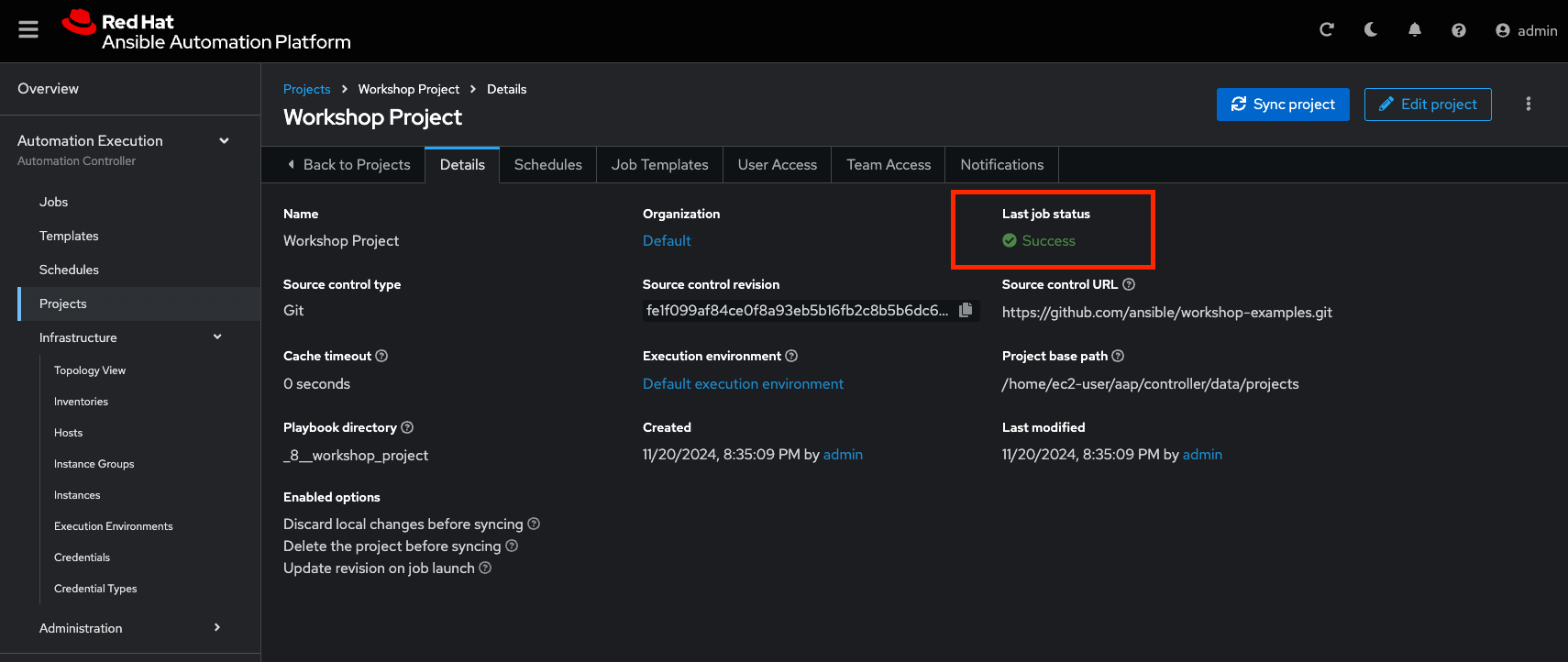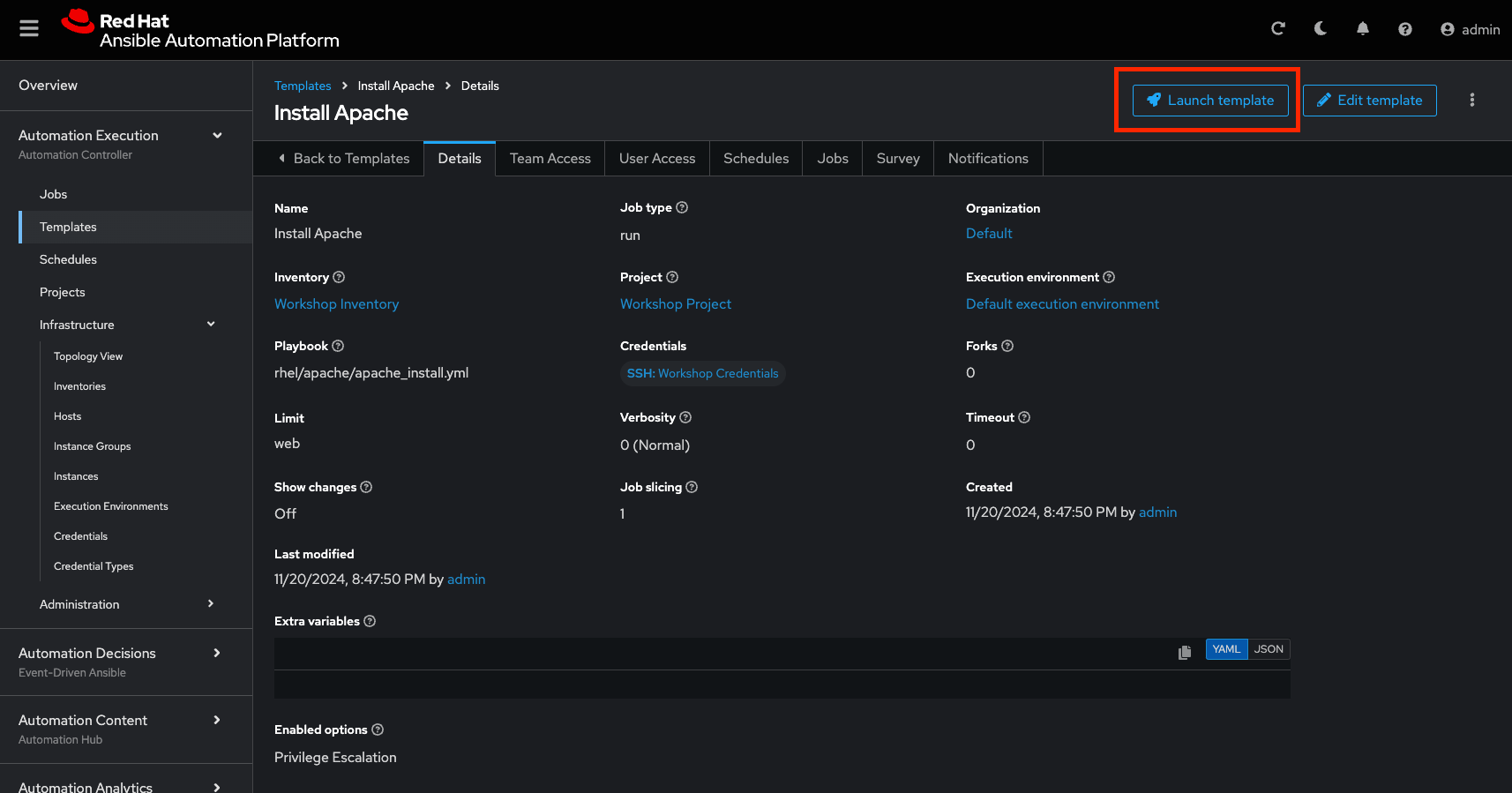Workshop Exercise - Projects & Job Templates
Read this in other languages:
 English,
English,  日本語,
日本語,  Portugues do Brasil,
Portugues do Brasil,  Française,
Française,  Español.
Español.
Table Contents
- Objective
- Guide
- Setup Git Repository
- Create the Project
- Create a Job Template and Run a Job
- Challenge Lab: Check the Result
- What About Some Practice?
Objective
An Ansible automation controller Project is a logical collection of Ansible playbooks. You can manage your playbooks by placing them into a source code management (SCM) system supported by automation controller such as Git or Subversion.
This exercise covers:
- Understanding and using an Ansible automation controller Project
- Using Ansible playbooks stored in a Git repository.
- Creating and using an Ansible Job Template
Guide
Setup Git Repository
For this demonstration, we will use playbooks stored in a Git repository:
https://github.com/ansible/workshop-examples
A playbook to install the Apache web server has already been committed to the directory rhel/apache, apache_install.yml:
---
- name: Apache server installed
hosts: web
tasks:
- name: latest Apache version installed
ansible.builtin.yum:
name: httpd
state: latest
- name: latest firewalld version installed
ansible.builtin.yum:
name: firewalld
state: latest
- name: firewalld enabled and running
ansible.builtin.service:
name: firewalld
enabled: true
state: started
- name: firewalld permits http service
ansible.builtin.firewalld:
service: http
permanent: true
state: enabled
immediate: yes
- name: Apache enabled and running
ansible.builtin.service:
name: httpd
enabled: true
state: started
Tip
Note the difference from other playbooks you might have written! Most importantly there is no
becomeandhostsis set toweb.
To configure and use this repository as a Source Control Management (SCM) system in automation controller you have to create a Project that uses the repository
Create the Project
- Go to Automation Execution → Projects click the Create Project button. Fill in the form:
| Parameter | Value |
|---|---|
| Name | Workshop Project |
| Organization | Default |
| Execution Environment | Default execution environment |
| Source Control Type | Git |
Enter the URL into the Project configuration:
| Parameter | Value |
|---|---|
| Source Control URL | https://github.com/ansible/workshop-examples.git |
| Options | Select Clean, Delete, Update Revision on Launch to request a fresh copy of the repository and to update the repository when launching a job. |
- Click Create project
The new project will be synced automatically after creation. But you can also do this manually: Sync the Project again by selecting the ‘Sync project’ blue button.

After starting the sync job, go to the Jobs view, and you’ll find the job doing the project update.
Create a Job Template and Run a Job
A job template allows you to run an automation job. In order to run any type of automation, a job template must be created. A job template consists of knowning the following information:
-
Inventory: On what hosts should the job run?
-
Credentials What credentials are needed to log into the hosts?
-
Project: Where is the playbook?
-
Playbook: What playbook to use?
To create a Job Template, go to the Automation Execution -> Templates view,click the Create template button and choose Create job template.
Tip
Remember that you can often click on the question mark with a circle to get more details about the field.
| Parameter | Value |
|---|---|
| Name | Install Apache |
| Job Type | Run |
| Inventory | Workshop Inventory |
| Project | Workshop Project |
| Playbook | rhel/apache/apache_install.yml |
| Execution Environment | Default execution environment |
| Credentials | Workshop Credential |
| Limit | web |
| Options | tasks need to run as root so check **Privilege Escalation** |
- Click Create job template
You can start the job by directly clicking the blue Launch template button, or by clicking on the rocket in the Job Templates overview. After launching the Job Template, you are automatically brought to the job overview where you can follow the playbook execution in real time.
Template Details

Job Run

Since this might take some time, have a closer look at all the details provided:
-
All details of the job template like inventory, project, credentials and playbook are shown.
-
Additionally, the actual revision of the playbook is recorded here - this makes it easier to analyse job runs later on.
-
Also the time of execution with start and end time is recorded, giving you an idea of how long a job execution actually was.
-
Selecting Output shows the output of the running playbook. Click on a node underneath a task and see that detailed information are provided for each task of each node.
After the Job has finished go to the main Jobs view: All jobs are listed here, you should see directly before the Playbook run an Source Control Update was started. This is the Git update we configured for the Project on launch!
Challenge Lab: Check the Result
Time for a little challenge:
- Use an ad hoc command on both hosts to make sure Apache has been installed and is running.
You have already been through all the steps needed, so try this for yourself.
Tip
What about
systemctl status httpd?
Warning
Solution Below
-
Go to Automation Execution → Infrastructure → Inventories → Workshop Inventory
-
In the Automation Execution → Infrastructure → Inventories → Workshop Inventory, select the Hosts tab and select
node1,node2,node3and click Run Command
Within the Details window, select Module command, in Arguments type systemctl status httpd and click Next.
Within the Execution Environment window, select Default execution environment and click Next.
Within the Credential window, select Workshop Credentials and click Next.
Review your inputs and click Finish.
Verify that the output result is as expected.
Tip
The output of the results is displayed once the command has completed.
Navigation
Previous Exercise - Next Exercise
Click here to return to the Ansible for Red Hat Enterprise Linux Workshop
